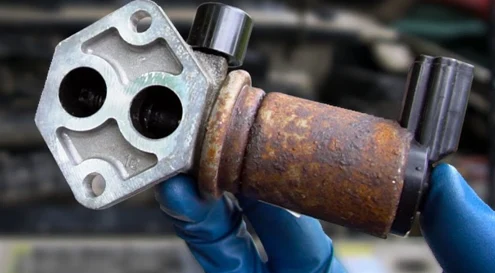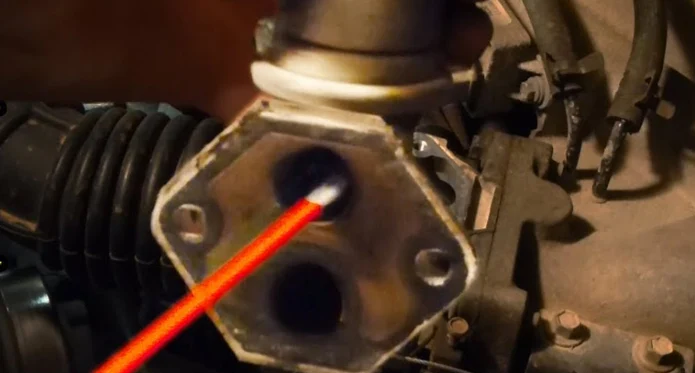Last Updated on February 8, 2023
The idle air control valve helps regulate the engine’s idle speed. If it becomes dirty or clogged, it can cause the engine to run too fast or too slow. It can also make the engine stall.
Many people think that they have to remove the entire air intake in order to clean this valve, but this is not the case. You can actually clean it without removing any parts.
If you have the right tools and a little patience, you can clean your IAC without removing it from your vehicle. In this guide, we’ll teach you how to clean an idle air control valve without removing it.
Steps on How to Clean Idle Air Control Valve without Removing

In the engine, idle air control valves are an important component of the engine, and it is necessary for regulating the amount of air that flows into the engine. Over time, the valve can become clogged, resulting in the engine running roughly.
If you notice that your engine is running roughly, you probably need to clean it. The good news is that you can clean the valve without disassembling the engine. Follow these steps to clean your idle air control valve:
Step 1: Prepare the Working area
Before starting to work on the idle air control valve, take some time to arrange the working area. Make sure that you have all the tools and materials that you need within easy reach. Clear away any clutter that could get in the way or that could potentially be disrupted during the cleaning process.
Once the area is clear, give it a good vacuum to remove any dust or debris that could interfere with the cleaning process. With a clean and well-organized working area, you can be sure that the job will go smoothly and that your results will be better.
Step 2: Disconnect the Negative Battery Cable
Most mechanics will tell you that the first step to cleaning your idle adjustment valve is to disconnect it from the battery. This prevents electrical shock while you’re working on the engine. To disconnect or remove your negative battery cable, locate the negative terminal on the battery and unplug the cable.
Once the cable is removed, set it aside in a safe place where it will not come into contact with any metal surfaces. Once the negative cable has been disconnected, you can move on to the next step.
Step 3: Remove the Air Intake Duct
This air intake duct is typically located near the front of the engine. To remove it, you’ll need to loosen and unscrew any bolts or clamps that are holding it in place. If the air intake is removed, you’ll be able to access the idle air control valve. If you can’t locate it, consult your vehicle’s repair manual.
Step 4: Clean the Idle Air Control Valve
When cleaning the idle air control valve, you will need to use a carburetor cleaner. Begin by disconnecting the battery. Next, locate the throttle body and remove the bolts that attach it. Once the throttle body is disassembled, you will be able to see the IAC.
Use a brush to clean any dirt or debris from the surface of the valve. Finally, use carburetor cleaner to clean the inside of the valve. Reassemble everything and reconnect the negative power cable.
Step 5: Test the Engine
After you’ve cleaned your idle air control valve, the best way to test your engine is to start it up and let it idle for a few minutes. If the engine is running smoothly, then you can be confident that you’ve successfully cleaned the valve.
If it is still running roughly, then it’s possible that you may need to replace the valve. Replacing an idle air filter is a relatively uncomplicated task, but it’s important to ensure that you get the right replacement part for your specific engine type.
Step 6: Take It for a Test Drive
When you are going to test drive your car, it’s important to make sure that the idle air control valve has been cleaned. This will help to ensure that it runs smoothly. After the valve is clean, you can reinstall it and then take your car out again.
Pay attention to how the engine sounds and feels while you’re driving. If everything seems normal, it’s probably clean. But if it’s still having problems, the valve may need to be replaced.
It is a relatively simple task that can be done without having to remove it from the engine. By following these steps, the valve will be cleaned and get your engine running smoothly again.
What are The Causes of a Dirty Air Control Valve?

The air control valve plays a critical component of any vehicle’s engine, as it regulates the flow of air into the engine. If the valve is clogged up, it can restrict airflow, causing the engine to work inefficiently and potentially leading to engine damage. The cause of dirty air control valves includes several factors, including:
Dirty air filter:
An unclean air filter may restrict the passage of air through the engine, causing its air control valve to become dirty. If the air filter is not replaced, the dirt will eventually make its way into the engine, where it can damage components and cause poor engine performance. A dirty air filter can also cause this component to stick, which can lead to a loss of power and decreased fuel economy.
Exhaust leaks:
Exhaust leaks are one of the most common reasons for clogged air control valves. When exhaust leaks occur, contaminants can enter the engine and collect on the intake valve.
This can cause the valve to become clogged and subsequently operate less efficiently. In some cases, a filthy air control valve can also lead to an engine stall or misfire.
Bad fuel injectors:
There is a possibility that the fuel injectors are not working properly due to a bad air control valve. If the injectors are not atomizing the fuel properly, then larger droplets of fuel can be introduced into the engine. These droplets can then collect on the air vent, causing it to become dirty.
Oil leaks:
A dirty air-conditioning valve is usually caused by oil leaks. Oil leaks can contaminate the air intake, preventing it from functioning properly. In some cases, oil leaks can also result in a valve sticking open, which can result in power loss. If you suspect that your air filter is dirty, it is important to have it inspected by a qualified technician.
FAQs
What are the symptoms of the dirty air control valve?

Having a filthy air intake valve can cause a number of symptoms in your vehicle, including reduced fuel economy, decreased power, and increased emissions. The most common symptom of poorly maintained air control valves is a reduction in fuel economy.
When the valve is dirty, it doesn’t open as far, which reduces the volume of air that enters the engine. This, in turn, lowers the engine’s efficiency and causes it to burn more fuel.
What will happen if I don’t clean my air control valve?
If you don’t clean your air control valve, its consequences can be serious. The most immediate problem is that your engine will not run as efficiently. This means that your car will consume more fuel, and your emissions will increase.
In the long term, deposits can build up in the valves, causing them to stick or even break. This can lead to expensive repairs, and in some cases, it may even be necessary to replace the engine entirely.
Is it possible to unclog the IAC valve?
The IAC valve is an integral part of the engine management system, which controls airflow to the engine. If the IAC valve becomes clogged, it leads to a number of problems, including reduced engine power, poor fuel economy, and increased emissions. While it may be possible to clear the IAC valve, it is generally not recommended.
Does the IAC valve need to be disconnected?
While most car repair shops will tell you it’s not necessary to disconnect the IAC valve when replacing the spark plugs, there are some who swear by it. It’s responsible for regulating the airflow into the engine, and it’s possible that disconnecting it could throw off the car’s idle.
On the other hand, some argue that disconnecting the IAC valve can help to prevent potential damage to the spark plugs. Ultimately, it’s up to you to decide whether or not to disconnect your IAC valve while changing your spark plugs.
Final Thoughts
It is necessary from time to time to clean your idle air control valve (IAC). If you don’t, it can get gummed up with carbon deposits and cause all sorts of problems. The IAC is what allows the engine to idle smoothly, so if it’s not working properly, the engine will either stall or run very roughly.
It is possible to clean the IAC without removing it from your engine if you follow these steps. We hope this article on how to clean idle air control valves without removing them has been helpful and informative.


